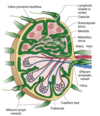PATHO - Term Test I (Hematologic System) Flashcards
(200 cards)
What are the 4 chief functions of blood?
1) delivery of substances needed for cellular metabolism
2) removal of wastes
3) defence against microorganisms and injury
maintenance of acid-base balance
Blood volume is approximately ___ L in adults.
5.5L (~6 quarts)
Plasma is made up of ___% water and ___% solutes. What is it and what % of blood volume is plasma?
- 91% water, 9% solutes
- component of blood that is an aqueous liquid containing variety of organic and inorganic elements
- accounts for 50-55% of blood volume
How is serum different than plasma?
serum is free of clotting proteins (which may be advantageous as some clotting proteins may interfere with diagnostic tests)
What gases exist in arterial plasma?
CO2
O2
N2
The following are waste products found in the arterial blood. They are the end products of what?
1) urea
2) creatinine
3) Uric acid
4) bilirubin
5) individual hormones
1) Urea: from protein catabolism
2) Creatinine: from energy metabolism
3) Uric acid: from protein metabolism
4) Bilirubin: from heme, from RBC destruction
5) Individual hormones: functions specific to target tissue
All of the following functions of proteins are true EXCEPT:
a) acting as buffers
b) providing colloid osmotic pressure of plasma
c) clotting factors, antibodies, hormones, transporters
d) binding other plasma constituents
e) all the above are functions of proteins
e) all the above are functions of proteins
What is contained in the Buffy coat?
platelets, WBCs
The 2 major plasma protein groups are ________. They are mostly produced by the _______.
albumins and globulins
mostly produced in the liver
What is the essential role of albumin? What happens when there is a decreased production/excessive loss of albumin?
- 57% of plasma protein (majority)
- essential role: regulation of passage of water and solutes through capillaries
- Too large so cannot diffuse freely through blood vessels therefore maintains colloid osmotic pressure instead
- if decreased/lost: fluid is retained in tissues and does not return to vascular system
What are globulins and how are they classified in the blood?
- accounts for ~38% of plasma protein
- classified by their movement relative to albumin:
- Alpha globulins: moving most closely to albumin (HDLs, prothrombin, hormone transporters)
- Beta globulins: LDLs
- Gamma globulins: least movement, primarily antibodies
Plasma proteins are classified by the following functions:
a) clotting
b) Defense/protection
c) transport
d) regulation
Please list an example or how these proteins specifically accomplish each function.
a) Clotting: fibrinogen ⇒ promotes clotting and stops bleeding from damaged blood vessels
b) Defense/protection: antibodies and complement proteins
c) Transport: binding and carrying inorganic/organic materials (ex. transferrin carrying iron, lipids, lipoproteins carrying steroid hormones)
d) Regulation: enzymatic inhibitors (protect from tissue damage); precursor molecules that become active when needed; protein hormones (cytokines) that communicate between cells
Describe the following of an erythrocytes:
a) structure
b) function
c) life span
A) no nucleus, biconcave disk containing Hb
b) gas transport to and from tissue cells and lungs
c) 80-120 days
Describe the following of a leukocyte:
a) structure
b) function
c) life span
a) nucleated (varied sizes, depends on the leukocyte)
b) body defence mechanisms
c) varied (depends on the leukocyte)
Describe the following re: a neutrophil.
a) structure
b) function
c) life span
a) granulocyte; several-lobed nucleus (polymorphonuclear)
b) phagocytosis (especially during early stage of inflammation)
c) 4 days
Describe the following re: eosinophil.
a) structure
b) function
c) life span
a) granulocyte, several lobed nucleus
b) control inflammation, phagocytosis, defense against parasites, allergic reactions
c) unknown life span
Describe the following re: basophils.
a) structure
b) function
c) life span
A) granulocyte, several lobed nucleus
b) mast cell-like functions, associated with allergic reactions (release histamine); also release heparin
c) unknown life span
Describe the following re: monocytes and macrophages.
a) structure
b) function
c) life span
a) large phagocyte, one nucleus (mononuclear)
b) phagocytosis
c) months to years
Describe the following re: lymphocyte.
a) structure
b) function
c) life span
a) mononuclear immunocyte
b) humoral and cell-mediated immunity
c) days to years, depending on type
Describe the following re: NK cells.
a) structure
b) function
c) life span
a) large granular lymphocyte
b) defense against some tumors/viruses
c) unknown
Describe the following re: platelets.
a) structure
b) function
c) life span
a) irregularly shaped cytoplasmic fragment
b) hemostasis after vascular injury; coagulation/clot formation and retraction; release of growth factors
c) 8-11 days
Erythrocytes account for ~___% of blood volume in men, and _____% in women. The range of RBCs is between ________ RBCs/mm3 of blood.
48% in men
42% in women
4.2-6.2 million
Describe the properties and function of an erythrocyte.
- Primary function: tissue oxygenation (Hb carries the gas, electroyles regulate gas diffusion through cell membranes)
- No organelles so no other cell functions or mitotic divisions
- Biconcave shape and reversibly deformable
- biconcave shape increases SA/V ratio optimal for gas diffusion
- reversible deformity into a torpedo shape to undergo diapedesis and squeeze through microcirculation
Describe the function and properties of leukocytes.
- Function: defence against organisms that cause infections, removes debris
- Avg: 5000 - 10 000 WBCs/mm3 blood
- Classified by structure:
- Granulocytes: neutrophils, basophils, eosinophils
- Agranulocytes: monocytes, macrophages, lymphocytes
- Classified by function:
- Phagocytes: neutrophils, basophils, eosinophils, monocytes, macrophages
- Immunocytes: lymphocytes




